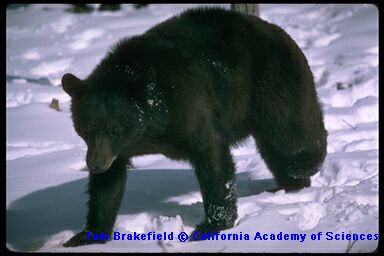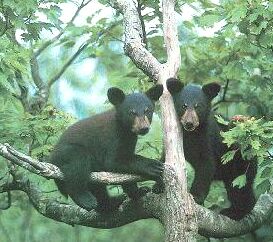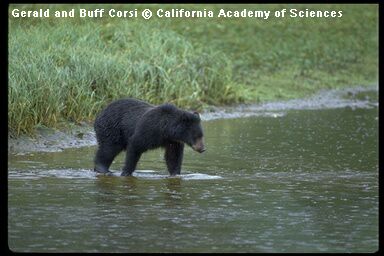RANGE
- found across Canada, including the north
- found in western United States
- lives in wooded areas and mountains
APPEARANCE
- smallest bear in North America
- male can be 2 metres ( 6 ft. ) in length ;
1 metre ( 3 ft. ) to the shoulders
- not all are black, some are dark brown or rusty brown
- brown patch on the nose, stubby tail, sharp claws
ADAPTATION
- able to climb trees, wraps front legs around the trunk
bear in a tree
- eats campers' food, goes into trash cans
- sleeps during the winter, might come out on warm days
WINTER
- looks for a den under a fallen tree, in a hollow log,
in a cave.
- may also dig a small hole in a hillside
- females line the den with grass and leaves
- eats alot in the fall to fatten up
- not a true hibernator
- very hungry when it comes out of the den in spring

ENEMIES AND PROTECTION
- was once hunted for sport
- now protected in some areas of Canada and the US
- illegally killed for their bladders, paws, other body parts
- has few enemies, animals are afraid to attack the bear
- strong, has powerful paws and sharp teeth
- can move fast for a short distance and can swim
THE YOUNG
- two or three cubs born every two years
- born in January or February
- newborns are naked and blind, 15 to 20 cm. long
- spend the winter in the den drinking mother's milk
- by May their coats have grown
- spend second winter with mother in the den
- cubs whine (sounds like a baby crying)

FOOD
- spend most of their time looking for food
- eat plants - twigs, buds, leaves, nuts, roots,
fruit, berries, plant shoots
- also eat ants, honey, fish
- use sharp claws to tear bark from trees and to rip open
rotten logs to look for insects and grubs
- climb trees for birds' eggs and to get to beehives
- sometimes eat small mammals
- catch fish with paws or teeth
- stand up on hind legs to smell

|




